|
|

This chapter describes management utilities available in the Element Management System (EMS).
Use the ping node utility to test network connectivity between the NE and another network element (such as a Cisco 6700 NE or a router).
From the NE provision window, select Ping Node from the function bar to open the ping node window. (See Figure 11-1.)
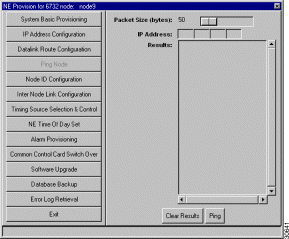
Set the following parameters:
Click Ping to ping the node. The results of the attempted ping are displayed in the Results list.
EMS offers three levels of security for EMS user accounts:
| Security Level | Permitted EMS Operations |
|---|---|
1 | Display the network topology and node configurations (read only). |
2 | Display the network topology (read only), and modify the node configurations (read/write). |
3 | Modify the network topology and node configurations (read/write), manage EMS user accounts, and provision EMS alarms. |
EMS users with level 3 security can create, delete, and modify user accounts from EMS. To launch the EMS user administration window, select Applications > Configure EMS Security from the net view menu. (See Figure 11-2.)
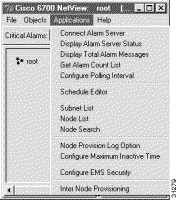
EMS launches the EMS security window. (See Figure 11-3.)
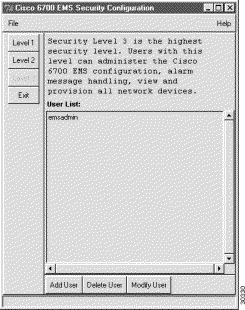
The EMS Security window lists all configured users within a given EMS security level. Click on the buttons labeled Level 1, Level 2, and Level 3 to display user lists for each level of EMS security. Figure 11-3 shows the Level 3 button is grayed out; this indicates that only level 3 user accounts are displayed.
Click the following buttons to configure EMS user accounts:
The EMS inactivity timer tracks the amount of time that a particular node view remains open. When the inactivity timer expires, EMS displays a dialog box asking if the node view should be kept active. Click Continue to close the dialog box and continue working in node view, or click Exit to close the node view. If no selection is made within 60 seconds, EMS closes the node view. The timer is set to 60 minutes by default.
To configure the inactivity timer, select Applications > Configure Maximum Inactivity Timer from the net view menu. Set the timer length in minutes and click Apply. To disable the inactivity timer, set the timer value to 0.
The EMS node search utility lets you locate a previously created node by entering the node name or IP address of the node. (See Figure 11-4.)
To launch the node search window, select Applications > Node Search from the net view menu.

To search for a node, enter either the node name or node IP address in the node search window, then click Search. EMS searches all subnets and end node lists for the specified node. If a matching node is found, the node name and node ID will be displayed in the text window.
To launch the node log display, right-click the node icon in net view, and select Node Provision Log from the popup menu. (See Figure 11-5.)

EMS launches the node provision log display. (See Figure 11-6.)

The information in the node provision log is categorized as follows:
Any of these categories can be selected singularly (click the desired category in the Category List box) to display specific types of system information.
The EMS slot provisioning security function allows selected slots in the Cisco 6732 or Cisco 6705 chassis to be protected from further provisioning changes. Protected slots, including the lines and cards in the protected slots, cannot be changed or modified.
To provision slot security on a node, complete the following steps starting from the EMS net view:
Step 1 Right-click the desired node icon and select Node Provision Management from the popup menu. (See Figure 11-7.)

EMS launches the node provision window. (See Figure 11-8.)

Step 2 Click the Slot Provisioning Security tab from the function bar. (See Figure 11-9.)
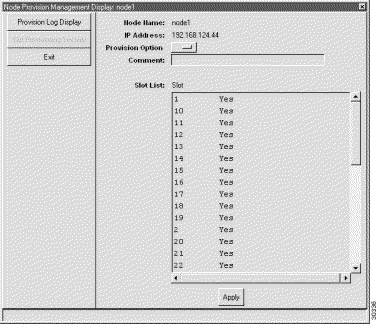
Step 3 In the Slot List window, click the slots to be provisioned.
Step 4 Set the Provision Option to Yes (allow slot provisioning) or No (disallow slot provisioning).
Step 5 Optionally, you can enter a Comment which will be displayed next to the affected slots in the slot list.
Step 6 Click Apply to provision the slots.
The EMS schedule editor lets you schedule software utilities such as database backups and software upgrades.
To open the schedule editor, select Applications > Schedule Editor from the net view menu. (See Figure 11-10.)

EMS launches the schedule editor. (See Figure 11-11.)
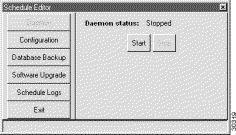
The schedule daemon must be activated for scheduled activities to take place. To activate the schedule daemon, click the Daemon tab, then click Start. You can stop the schedule daemon by clicking Stop.
The schedule editor provides a configurable procedure timeout, allowing EMS to set a maximum time for database backup and software upgrade procedures. To set the timeout value, click the Configuration tab and enter the desired timeout length in minutes.
To schedule a database backup, click the Database Backup tab. EMS launches the database backup scheduler window. (See Figure 11-12.)
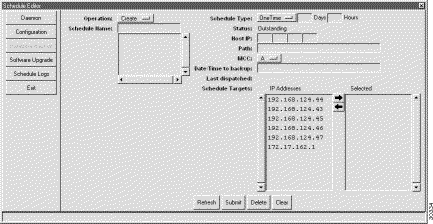
Set the following parameters to schedule a database backup:
Click Submit to complete the new schedule.
To schedule a software upgrade, click the Software Upgrade tab. EMS launches the software upgrade scheduler window. (See Figure 11-12.)

Set the following parameters to schedule a software upgrade:
Click Submit to complete the new schedule.
Click the Schedule Log tab to display a detailed log of all scheduled activities. Click Save Overview to create a file containing the overview information (top list), or click Save Detailed to create a file containing detailed log information (bottom list).
![]()
![]()
![]()
![]()
![]()
![]()
![]()
![]()
Posted: Fri Mar 3 15:40:49 PST 2000
Copyright 1989 - 2000©Cisco Systems Inc.